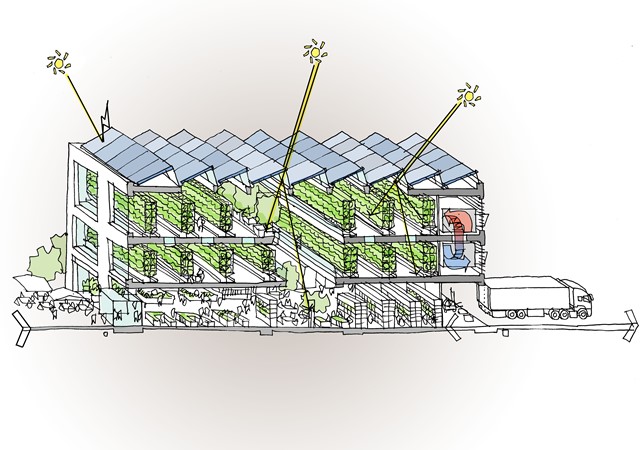sustainable design
UK
--
--
--
We are now carrying out research with Jay Stuart’s Office of Sustainable Design and AgTech company Liberty Produce to transform buildings, urban spaces and modern agriculture.
It is dawn in Almeira. For as far as the eye can see, robots track methodically across a patchwork landscape of plastic wrapped fields. On the horizon, a huge convoy of refrigerated trucks drives through a sea of dust on its 2,000 kilometre journey to London.
We import nearly half our vegetables, some 2.3 million tonnes a year, from Spain and further afield. Food politics - and economics- is already a highly complex subject and Brexit will bring its own set of issues, but what is clear is that continuing to obtain our food in this way is not sustainable. This method of production demands massive use of water in often relatively arid areas, and substantial road or air haulage with attendant CO2 emissions. A lot of that plastic also ends up in the sea.
Meanwhile, back in the UK, there is also an increasing demand for fairly traded food of known provenance which does not need to be chemically rinsed to preserve its freshness. Farmers’ markets and more mainstream supermarket initiatives, have demonstrated the attractions of responsibly and locally produced food.
At the same time, large parts of our building stock in urban areas are becoming obsolete. Many deep space, single purpose buildings, such as multi storey car parks and medium scale shopping centres, will not survive the changes in transport patterns and shopping behaviour now underway. While demolition and rebuilding may seem to be the obvious option, repurposing makes more sense environmentally. There is a real opportunity to modify these structures so they continue to perform their existing roles, supplemented by additional uses that will make them more interesting, valued buildings.
There is a toolkit of other uses that might inhabit or grow out of these structures, from workspace to residential, but using them for food production is as yet little understood. The common image of hydroponics is of men in white coats tending salad crops in strangely lit enclosed environments, such as shipping containers, in edge of town industrial estates. In fact, the technology now exists to develop a much more diverse range of architectural environments. People like plants. While sealed hydroponic pods may answer part of the question of food production, subtropical greenhouses connected to restaurants in orangeries fuelled from free, exhausted heat may do so in a more exciting, environmentally sustainable way.
The London plan now has robust measures in place to mitigate the environmental impact of new housing development. Carbon neutral energy strategies and drainage systems to manage water run off are demanded and car parking is heavily restricted. In its place, bicycle parking is required and developers need to find roughly one sq metre per resident to house them. One sq m could also generate 100 kg of vegetables per year, which is conveniently what that resident will need. This could directly address the environmental issues created by shipping all that produce in from the southern reaches of Europe and beyond. About 550 litres of rain water drop on every sq m of London every year and managing flood risk is an issue for all new buildings. That water can simply be collected at roof level and used to supply these hydroponic systems.
Similarly schools, even on restricted urban sites, could house growing areas that not only contributed to school lunches, but also provided a valuable educational tool.
The technology exists and so does the will to reap its obvious benefits. Our focus is on developing new strategies for both repurposing existing buildings and designing new environments so that they enhance those structures and transform how they are used.



